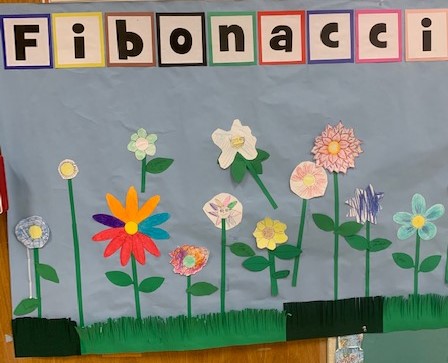
Fibonacci Flower Garden Collaborative Project

I’m always looking for ways to combine math and art into a fun activity. I’m also always looking for ways to show students that we’re surrounded by math in ways we aren’t necessarily aware of. That brings me to a recent Family Math Night Collaborative Project.
In this project I used the Fibonacci numbers to have participants create a Fibonacci Flower Garden. Fibonacci numbers are a sequence of numbers that are generated by adding the previous two numbers starting with 0 and 1.
0, 1, 1, 2, 3, 5, 8, 13, 21, etc.
What’s so cool about these numbers is that they’re found throughout nature. In flowers. In pinecones. In nautilus shells. In spiral galaxies. They help underscore that math is really our way of describing the universe we live in.
I’ve put together a FREE lesson plan for those of you who are interested in doing this at your Family Math Night event. But it can also be done in the classroom. And it’s a perfect activity as we head into the spring season and flowers begin to bloom.
I also have another super fun math and art activity that I do in the upper elementary grades. It involves the Fibonacci spiral. Here’s a link to a blog I wrote about it years ago.
What I like about these projects is that bringing art into the equation (!) is a great way to show students that math can be described in visually artistic ways.
Be sure to check our my other fun math and art projects.
4 thoughts on “Fibonacci Flower Garden Collaborative Project”
Family Math Night’s blog post on creating engaging math activities for children provides valuable resources and practical ideas for parents and educators. The emphasis on making math fun and relevant to real-life situations helps to foster a love of learning in children. Thank you for sharing these wonderful suggestions for incorporating math into everyday family activities!
Thank you, Eva, for sharing your appreciation for what we do at Family Math Night! You are so right – if we can engage students and their families in engaging activities that show how math is simply something we do in our daily lives then they will build confidence and develop an understanding of the power and beauty of mathematics.
Your post about Family Math Night and the interesting activities you provided were quite interesting to read. landscapers Edmonton When math is taught in this engaging fashion, it can be so much fun. Continue the amazing effort!
Thank you for your kind comments! I agree – when math is more engaging, kids absorb the learning. It’s a win/win!